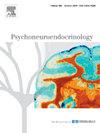头发中激素水平与围产期抑郁之间关系的系统性回顾。
IF 3.6
2区 医学
Q2 ENDOCRINOLOGY & METABOLISM
引用次数: 0
摘要
围产期抑郁症是一个全球性的健康问题,其特点是在妊娠期至产后 12 个月内出现情绪紊乱。荷尔蒙在妊娠维持、胎儿发育、分娩和生产过程中起着至关重要的作用,并随着妊娠和分娩而发生显著变化。然而,这种维持生命的变化可能会导致围产期抑郁症的风险。迄今为止,大多数与围产期抑郁症有关的荷尔蒙研究都侧重于血液或唾液采样方法,但头发分析可提供有关荷尔蒙浓度在更长时间内(即数月内)变化轨迹的独特信息。本系统性综述旨在全面回顾围产期毛发激素(即皮质醇、孕酮、雌激素和睾酮)测量值与抑郁之间的关系。共有 41 项研究被纳入其中。大多数研究报告的相关性在统计学上为零。人与人之间的研究在报告的毛发激素与抑郁关系的方向和程度方面差异很大,这很可能是由于采用了多种方法,包括评估时间和样本大小。使用人体内方法进行的研究观察到皮质醇浓度与症状在不同时间的正相关性。大多数研究只关注皮质醇。我们建议未来的研究同时考虑压力荷尔蒙和生殖荷尔蒙,鉴于这是一个剧烈变化的时期,应优先考虑人体内荷尔蒙水平的变化,并纳入可能会改变围产期荷尔蒙变化以及荷尔蒙水平与抑郁之间关系的环境特征(如社会支持、不利和有利的童年经历、身体和精神状况)。本文章由计算机程序翻译,如有差异,请以英文原文为准。
A systematic review of associations between hormone levels in hair and peripartum depression
Peripartum depression is a global health concern, characterized by mood disturbances inclusive of pregnancy through up to 12-months postpartum. Hormones play a vital role in pregnancy maintenance, fetal development, and labor and delivery and change significantly as a function of pregnancy and childbirth. However, such life sustaining changes may have consequences related to risk for peripartum depression. To date, most studies that have examined hormones in relation to peripartum depression have focused on blood or saliva sampling approaches, though hair analysis offers unique information on trajectories of hormone concentrations over more sustained periods of time (i.e., over months). The aim of this systematic review was to provide a comprehensive review of the association between hair measures of hormones (i.e., cortisol, progesterone, estrogen, and testosterone) and depression during the peripartum period. Forty-one studies were identified for inclusion. A majority of studies reported statistically null associations. Between-person studies varied widely in reported direction and magnitude of hair hormone–depression associations, most likely attributable to a wide range of methodological approaches including timing of assessments and sample size. Studies using within-person approaches observed positive coupling of cortisol concentration and symptoms across time. Most studies focused exclusively on cortisol. We recommend future research consider both stress and reproductive hormones, prioritize within-person change in hormone levels given this is a period of dramatic change, and include contextual (e.g., social support, adverse and benevolent childhood experiences, physical and psychiatric conditions) features that may modify both changes in hormones and the association between hormone levels and depression in the peripartum period.
求助全文
通过发布文献求助,成功后即可免费获取论文全文。
去求助
来源期刊

Psychoneuroendocrinology
医学-精神病学
CiteScore
7.40
自引率
8.10%
发文量
268
审稿时长
66 days
期刊介绍:
Psychoneuroendocrinology publishes papers dealing with the interrelated disciplines of psychology, neurobiology, endocrinology, immunology, neurology, and psychiatry, with an emphasis on multidisciplinary studies aiming at integrating these disciplines in terms of either basic research or clinical implications. One of the main goals is to understand how a variety of psychobiological factors interact in the expression of the stress response as it relates to the development and/or maintenance of neuropsychiatric illnesses.
 求助内容:
求助内容: 应助结果提醒方式:
应助结果提醒方式:


